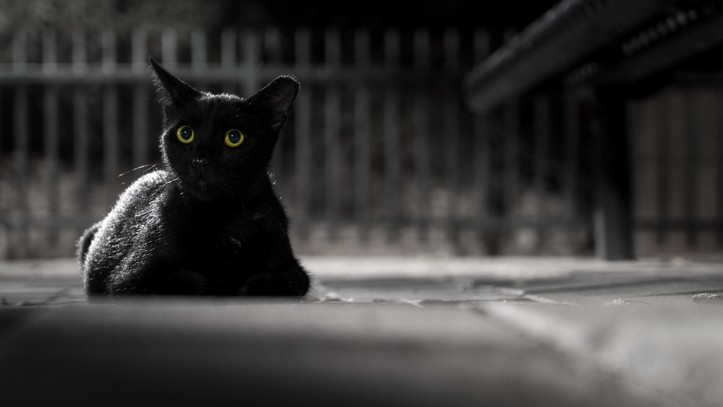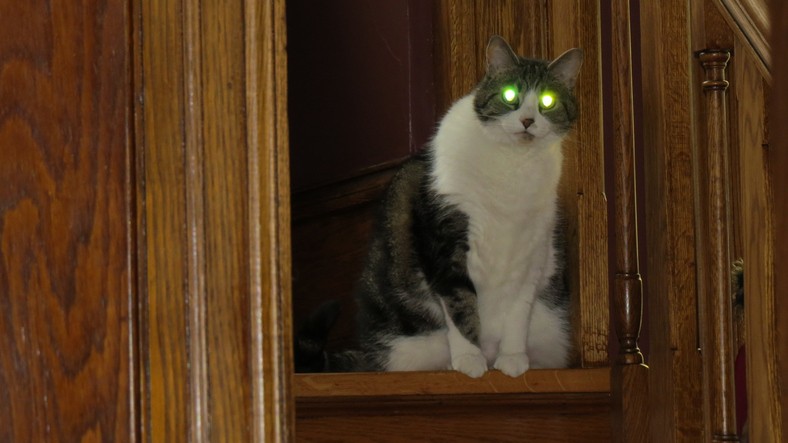Can cats see in the dark?
If your moggy insists on staying out all night, you may have often found yourself wondering... can cats see in the dark?

If you’re the owner of a feline, you’ll most likely be used to waking up to a “present” that they’ve caught for you during the night, so it’s a common thing to question: can cats see in the dark?
Based on the fact that many cats like to go out at night and are able to hunt small animals such as birds and mice, you wouldn’t be on your own in presuming that the answer was a resounding ‘yes’.
However, just like us, cats can’t see if it’s completely pitch black - they don’t have special built-in night vision goggles or anything!
So don’t be fooled into thinking cats are nocturnal creatures just because you so often find your moggy lounging in their best cat hammocks all day and every day. Why do cats sleep so much during the day anyway? Surely they wouldn’t need to if they weren’t creatures of the night!
With that said, there’s a lot more to a cat’s vision when it comes to the darkness of the night.
How do cats see in the dark?
As mentioned before, cats can’t see if it’s complete and total darkness outside. Like us, there needs to be at least some light in order for them to see. However, unlike us, they only need a sixth of the amount of light that we do, so are able to see in very low light conditions.
Therefore, even though they can’t officially see in the dark, they do a much better job of it than we do!
Get the best advice, tips and top tech for your beloved Pets
This is because the structure of their eyes mean that they are well adapted for low levels of light. They have large lens’ and curved cornea as well as pupils that are able to dilate from vertical slits to wide circles when necessary, which helps allow as much light in as possible.
Felines also have an extra special layer in their eyes, similar to animals such as dogs and foxes, called the tapetum lucidum or a “mirror layer”. It’s this layer of reflective tissue that is able to bounce light to the back of the eye, providing the retina with 50% more of the available light that’s around them.
It’s this tapetum lucidum that makes your feline’s eyes glow when a torch or artificial light is shone in their direction or you take a picture of them with the flash on, only to find that their eyes have literally lit up in the photo.
Fun fact: in most cats, the tapetum lucidum will glow a golden, silvery-green. However, in Siamese cats, their mirror layer tends to glow ruby-red when an artificial light reflects off of it.

Can cats see better in the dark than in the light?
Cats fall into the category of being ‘crepuscular’ animals, meaning that they are commonly more active during dawn and dusk when the light levels are minimal (and of course the time in which their prey are starting to stir or get ready to bed down for the night).
As mentioned above, cats can see in the dark much better than we can with even less light than we need.
This is because moggy’s have more photoreceptor rods in their eyes, which are responsible for the feline’s peripheral vision (everything an individual is able to see without moving their head), sensing movement, and seeing in the lowest levels of light.
In comparison, humans possess more photoreceptor cones than rods, which helps us to distinguish between colours as well as to see better during the day.
What do cats see when it's dark?
During the day, cats are famous for their vertical, slit-shaped pupils. However, during the night (or when they are feeling somewhat playful and mischievous), these pupils will transform into full circles.
Having slits for pupils allows the animal to focus, especially when they use their horizontal eyelids to reduce their window of vision (by squinting as such), allowing them to really hone in on their target.
In 2015, researchers from the University of California, Berkeley, discovered a link between animals who have vertically slit pupils - such as cats - and those that ambush their prey as opposed to forage for it, which strengthens the theory that they are able to focus clearly as a result of the shape of their pupil. They also concluded that many of the species who featured vertically slit pupils were also shorter in stature and lower to the ground, all of which helped the individual to determine how far away their desired prey is.
When a cat’s iris changes to circles however, it allows more light in (especially when there isn’t all that much available in the first place) but this also makes what they are looking at quite blurry.
Paired with the fact that cats are near-sighted - meaning that they can’t see all that far into the distance - their night vision in some instances can actually be fairly poor.
What cats can see however, especially in the dark, is both related to the structure of the eye and the way in which they view colour, which you can read more about in this article: Do cats see color?
Chloe is a freelance writer, editor, and proofreader, who has more than ten years’ experience in creating animal-focussed content. From National Geographic to Animal Planet, Chloe’s passion for creating fact-filled features all about wildlife and the environment is evident. But it’s not just wild animals that Chloe’s fascinated by. Having written more than 75 articles for PetsRadar - and having her very own four-legged friend by her side - it’s no wonder that her love of dogs (and, of course, cats) has grown exponentially.
Her website, www.chloemaywrites.com, and social media pages - @ChloeMayWrites on Instagram, Facebook, and Twitter - showcase her knowledge through daily facts and trivia tidbits. For example, did you know that snails have teeth?!

